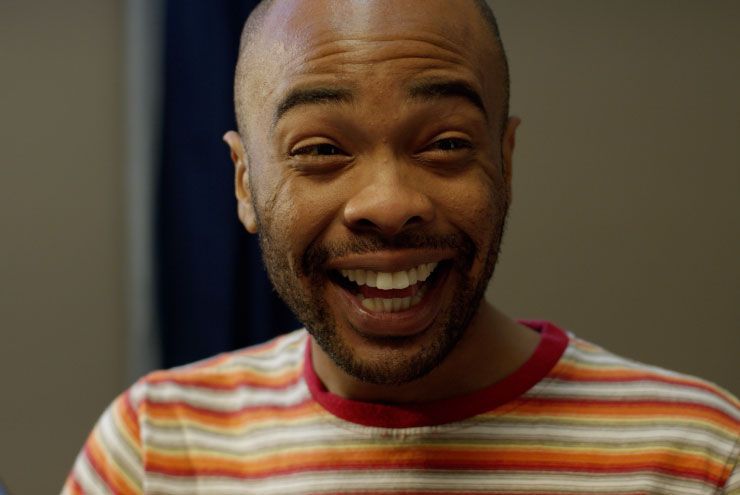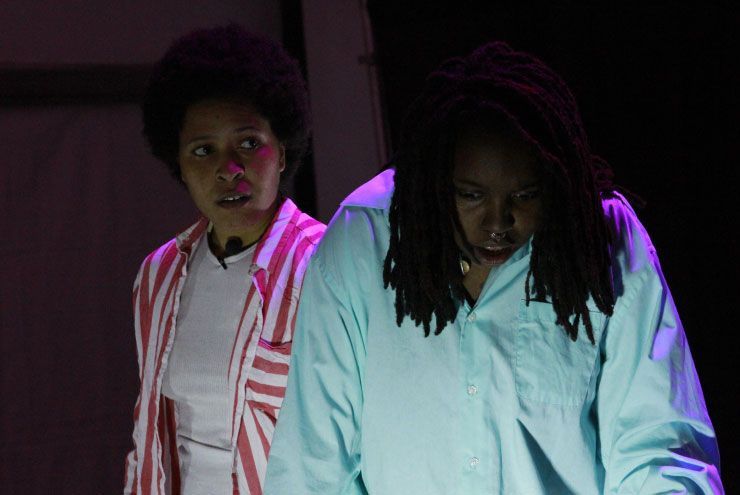By Autumn Rendall
TW: Mention of suicide and self-harm.
While Pride month may be over, the Museum of Fine Arts, Houston (MFAH), is keeping the queer vibes alive all summer long. As part of their virtual cinema program, MFAH is streaming three queer films: Against The Current and Truman & Tennessee: An Intimate Conversation (which the Museum premiered in June), and Can You Bring It: Bill T. Jones and D-Man in the Waters, which debuted on July 16. Although these films vary greatly, each tells a beautiful and deeply engaging story about the lives of queer people. Below you’ll find a preview of, as well as information on how to stream, each of these LGBTQ masterpieces.
Against The Current

Photo courtesy the Museum of Fine Arts, Houston.
Against The Current, directed by filmmaker Óskar Páll Sveinsson, follows then-43-year-old trans kayaker Veiga Grétarsdóttir on her journey to becoming the first person in the world to paddle counterclockwise, or against the current, along the entire Icelandic coast. As each day passes, the challenge of Grétarsdóttir’s feat becomes increasingly apparent, as you witness her power through the ice-cold, choppy waters for more than 100 days and 1,300 miles. She paddles for as many as 13 hours per day, and pulls into the coast to eat and sleep.
Footage of Grétarsdóttir’s grueling journey is interwoven with interviews with the kayaker, her family, friends, and other important people in her life, which detail Grétarsdóttir’s coming out process and transition. As we learn more about the terrible pain Grétarsdóttir experienced in order to become her true self, we realize how this previous hardship has transformed into motivation as she now paddles through the rough waters ahead.
During her journey, Grétarsdóttir also collects pledges for Pieta, a charity that provides free, accessible counseling to people suffering from suicidal distress or engaging in self-harm. Grétarsdóttir explains that the cause is close to her heart, since she previously attempted suicide two separate times and understands what it’s like to be in that dark headspace.
“I’ve dreamed of it for a long time, but never dared until now,” Grétarsdóttir says of her countercurrent paddle. “But having gone through everything, the transitioning, I decided to live my life and make my dreams come true.”
Truman & Tennessee: An Intimate Conversation

Photo courtesy Getty Images.
Truman & Tennessee: An Intimate Conversation, directed by Lisa Immordino Vreeland, dives into the friendship and unique—sometimes conflict-causing—connection between iconic American writers Truman Capote and Tennessee Williams. Through the use of archival material, and the voices of Jim Parsons for Capote and Zachary Quinto for Williams, the parallels between the two writers emerge—how their queerness, complicated family upbringing, and outlooks on life impacted their art and legacies. Even if unfamiliar with these writers’ works, the film relays the strong and eternal cultural impact Capote and Williams had on the world—we see clips of the various film adaptations made from Williams’s and Capote’s work, including The Glass Menagerie, Breakfast at Tiffany’s, In Cold Blood, Cat on a Hot Tin Roof, Baby Doll, and more.
Throughout their lives, Capote and Williams walked the line between mutual annoyances and the most deeply intertwined of friends. The film presents this dynamic in a deeply engaging dichotomy. We see the two navigate the fallout of various petty dramas—such as one calling the other unintelligent on national television—while simultaneously witnessing the pair’s deep attachment to one another as fellow queer artists. These artists’ words, equal parts whimsical and haunted, leave viewers curious to hear more.
Can You Bring It: Bill T. Jones and D-Man in the Waters

Photo courtesy the Museum of Fine Arts, Houston.
Can You Bring It: Bill T. Jones and D-Man in the Waters, co-directed by Rosalynde LeBlanc and Tom Hurwitz, is a documentary that shows the incredible history and legacy of one of the most important works of art to come out of the AIDS crisis—choreographer Bill T. Jones’s lyrical ballet, D-Man in the Waters. The film connects the story of the original Bill T. Jones/Arnie Zane company’s creation with a present-day college program’s journey to perform the piece and to discover its meaning for themselves.
From the beginning of the film, the beauty of the dance moves in D-Man is undeniable. Yet, as we learn more about the show’s origin, as well as the impact of the AIDS crisis on Jones and Zane, the meaning behind each move becomes layered. You’ll find yourself engrossed in the way each motion intertwines with the next, the emotion behind every action, and the palpable force of love and protection between each of the dancers. At its core, we see that D-Man is not only about the impact of constant, heartbreaking loss, but how we go about living through it and how we must rely on each other to stay afloat.
Even though D-Man premiered in 1989, we see, through the work of the present-day college students, that even decades later, the show continues to be eternally relevant. As LeBlanc directs the college students’ rehearsals and performance of D-Man, she teaches the students about the origins of the production and deeply encourages them to dance with greater meaning in their hearts, just as the original company once did. Watching the students evolve from simply doing the choreography (albeit flawlessly) to truly “seeing” one another as they dance is breathtaking.
To stream these films, visit MFAH’s virtual cinema page. A portion of your ticket helps support the MFAH film department.







